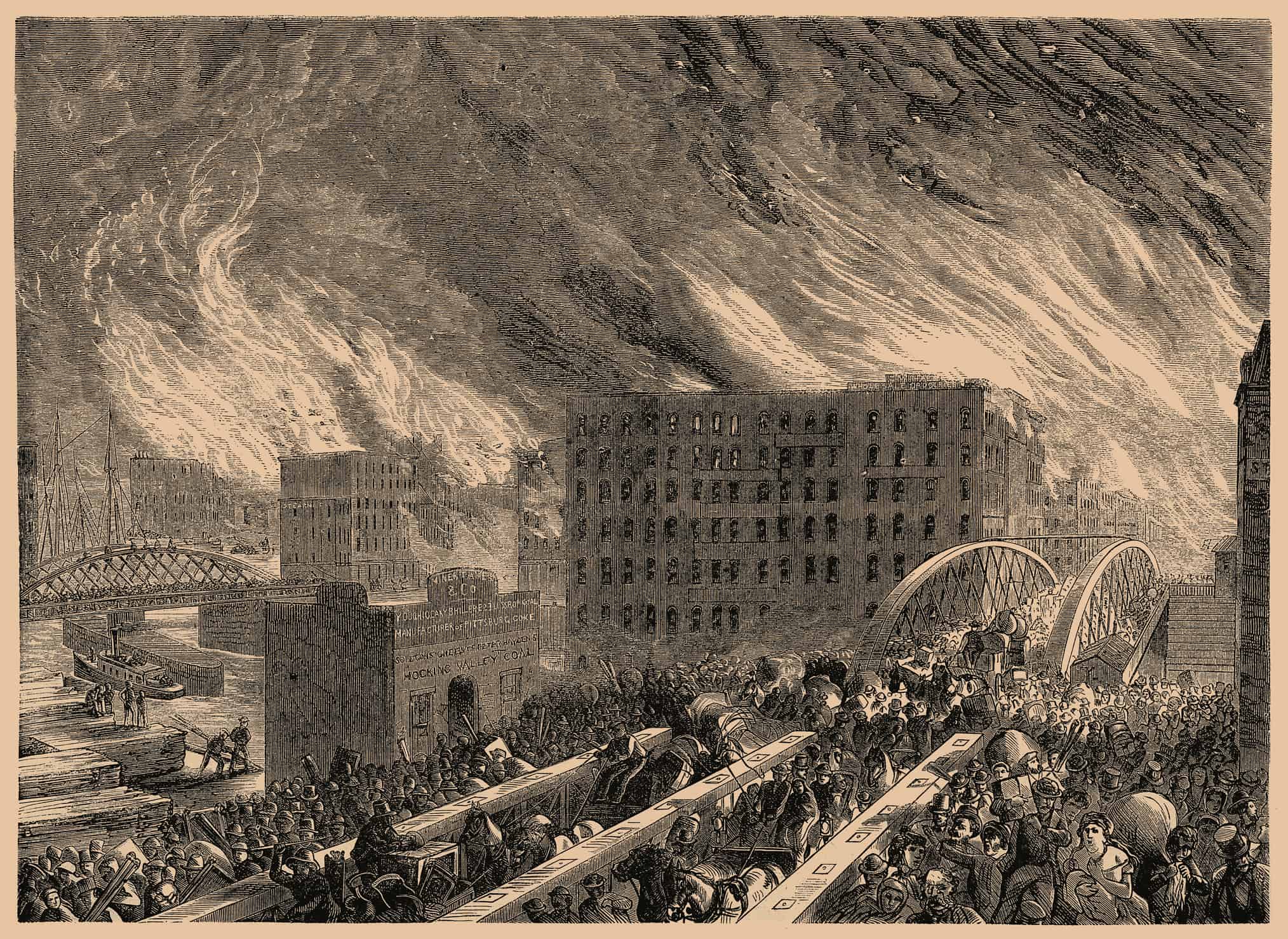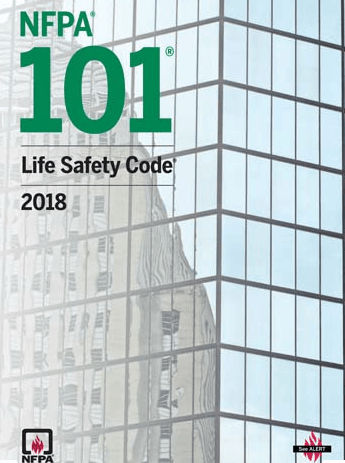Life Safety Lessons
Life Safety Lessons for Commercial Buildings
Veterans of life safety construction are familiar with the history of the MGM Grand Hotel fire in Las Vegas and how it influenced high-rise building codes and standards. But those newer to the industry may not be aware of the fire’s impact.
Great Fires Have Led to Reform
Disasters across the country and the resulting loss of life inspired the development of building codes to ensure public safety. Examples include the 1871 Great Chicago Fire, after which the Chicago Building Ordinances of 1875 were established; the 1906 San Francisco Earthquake and Fire, which spurred the development of the California State Tenement Housing Act in 1909; and the Boston Building Code of 1873, resulting from the 1872 Boston Fire[i].

Great Chicago Fire of 1871
Tragedies resulting from disasters and inadequate safety provisions also led to improvements in existing building codes. This was the case with the MGM Grand Hotel and Casino fire in Las Vegas in 1980. Toxic fumes from melted/burning PVC piping and a lack of sprinklers contributed to the deadly fire. Eighty-five people died mostly from poisonous gases and smoke inhalation. About three months later, another hotel fire at the Las Vegas Hilton had eight fatalities. These two tragedies led to major fire safety reforms that had historic impact.
Recent Fires Led to Safety Reforms
Often building materials, such as combustible exterior cladding and insulation, are culprits in accelerating deadly fires. This was the case with London’s Grenfell Tower fire in 2017, which burned for 60 hours, killing 72 people and injuring 70.
“The cladding went up like a matchstick,” said one resident.
It was the deadliest residential fire in the United Kingdom since WWII. The same type of cladding, which is not suitable for fire-resistive construction, was nonetheless used on other residential towers in the UK and other countries. While known to be combustible — “The cladding went up like a matchstick,” said one resident — the aluminum-polyethylene cladding was frequently used in projects where cost pressures were intense; the combination with PIR (polyisocyanurate) foam plates and a ventilation gap between the two was known to violate building standards. The investigation led to years of scrutiny on many fronts, and ongoing efforts to replace the cladding on the hundreds of structures where it was installed. In 2018, the government banned flammable cladding on new buildings of a certain height, schools, student housing, and residential care facilities[ii].
The Life Safety Code® (NFPA 101®)
 The Life Safety Code®, published by the National Fire Protection Association (NFPA), is a consensus standard that has been widely adopted in the United States. Known as NFPA 101®, the standard is not a legal code in itself but provides code-ready language that has been adopted into law by many jurisdictions. The standard generally addresses “those construction, protection, and occupancy features necessary to minimize danger to life from the effects of fire, including smoke, heat, and toxic gases created during a fire.” The standard does not include the “general fire prevention or building construction features that are normally a function of fire prevention codes and building codes[iii].”
The Life Safety Code®, published by the National Fire Protection Association (NFPA), is a consensus standard that has been widely adopted in the United States. Known as NFPA 101®, the standard is not a legal code in itself but provides code-ready language that has been adopted into law by many jurisdictions. The standard generally addresses “those construction, protection, and occupancy features necessary to minimize danger to life from the effects of fire, including smoke, heat, and toxic gases created during a fire.” The standard does not include the “general fire prevention or building construction features that are normally a function of fire prevention codes and building codes[iii].”
The Life Safety Code® originated in 1913 through a study of fires involving loss of life (such as New York City’s tragic Triangle Shirtwaist Factory Fire in 1911, with 146 fatalities), leading to standards for exit features such as stairways and fire escapes in factories, schools and other facilities. After a terrible series of fires between 1942 and 1946 – including the Cocoanut Grove Nightclub fire in Boston, with 492 dead– what was then known as the Building Exits Code began to take on more legalistic language that was suitable for legislation. In 1966, the name was changed to Code for Safety for Life from Fire in Buildings and Structures, and an ongoing 3-year cycle of revisions was established.
The Life Safety Code® is unusual in that it applies to both existing as well as new structures.
Cast Iron Soil Pipe: Naturally Noncombustible
Cast Iron Soil Pipe (CISP) is the logical choice for high-rise commercial and residential buildings. CISP systems naturally promote life safety when fire is present in a building. CISP is fire-resistive, will not melt, and maintains its structural integrity.
Importantly, CISP doesn’t emit toxic fumes when overheated in a fire.
These fire-resistive qualities and lack of toxic fumes means it’s healthier for occupants and first responders than plastic systems, which combust at 140 to 200 degrees F.
Today’s commercial buildings have fire-rated separations to contain the spread of flame and smoke. When fire separations are penetrated by piping systems they must be properly stopped. Failure to properly fire stop puts occupants and property at risk.
CISP Fire Stopping Is Simpler and Faster
Cast iron soil pipe systems fire stopping is a simpler and less expensive process than PVC pipes, which require consideration of many variables. Designers and engineers can avoid the added cost and complexity of adding fire stopping materials to their piping assemblies for every penetration in a building. To seal a cast iron penetration apply mortar, mineral wool batting, and/or fire-resistant caulking around the pipe. It’s simpler, faster and much more cost effective. And the more floors in the building, the greater the cost savings.
For combustible materials like plastic, the pipe penetrations must be sealed with additional fire stop materials, at significant expense, to the original fire integrity of the compartment with a fire-stopping system tested by a nationally recognized lab to ASTM E-84 or UL 723 Smoke and Flame Spread test.
Modified Testing for Fire Safety
The ASTM E84 standard is the measure that AEC industry professionals rely on to ensure that products used in a structure will not create additional risk to life during a fire. The 10-minute test measures the flame spread index (FSI) and smoke developed index (SDI) of a product within a standardized Steiner tunnel chamber. For true comparison, the test parameters should be the same for all test materials. However, some manufacturers have found ways to modify the testing procedures or set-up in ways that allow the product to meet the minimum flame and smoke characteristics as established by the E84 standard. These modifications may include additional materials to support the product sample within the tunnel. This has the effect of lowering the flame spread index as compared to the product without such support. Or they may include filling plastic piping with water before the test to positively affect the results. Determining whether a modified ASTM E84 test or revised standard has been used on a product is difficult, but well worth the research to protect the public[iv].
Follow Codes and Avoid Tragedy
Finally, even where codes and standards apply, if they are not respected or good judgment is not used, they serve no purpose. The Station Nightclub fire from February 2003 provides a case in point. The authorities granted the Nightclub, located in a wooden building from 1943, an exception to required ceiling fire sprinklers. That terrible fire killed 100 people and injured 230 when a pyrotechnic display ignited flammable foam soundproofing material. Poor interior flow design, badly marked exits, flammable materials and pyrotechnics in an enclosed space without sprinkler systems all contributed to the accident. As a result, changes to the fire code were enacted that lowered the occupancy threshold for mandatory sprinklers[v].
Usually it is not just a single factor that leads to a disastrous fire. Lack of regulation, building codes and standards that are not enforced, poor management and communication, and a desire to cut costs can result in tragedies that should have been prevented.
Cast iron soil pipe, as a noncombustible building element, can benefit the fire-resistive qualities of a building.
[i] Source: Building Codes 101, Part 1: Introduction to Building Codes, ICC website
[ii] Source: [https://en.wikipedia.org/wiki/Grenfell_Tower_fire] [https://metro.co.uk/2017/06/14/grenfell-tower-had-just-had-an-8-7m-refurb-but-was-new-cladding-to-blame-6707294/
[iii] https://en.wikipedia.org/wiki/Life_Safety_Code: NFPA 101, Life Safety Code 2006
[iv] Source: https://www.phcppros.com/articles/12577-modified-testing-for-products-all-smoke-and-mirrors, parts of which are abstracted from “The Risk of Using a Modified ASTM E84 Standard Test Method for Surface-Burning Characteristics,” ASPE Pipeline. ©2020, American Society of Plumbing Engineers.
[v] Source: https://www.iccsafe.org/building-safety-journal/bsj-dives/remembering-the-station-nightclub-fire/?fbclid=IwAR0rsQWwlR1VNkQCYM69zdYUEZ-FgAbiE4K70KyK_72CJckaM6y4ri_9460
Subscribe to CISPI eNews
Subscribe to the Institute’s eNewsletter, Cast Iron Crew News.
Subscribe NowSubscribe to CISPI eNews
Subscribe to the Institute’s eNewsletter, Cast Iron Crew News.
Subscribe Now